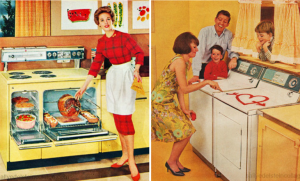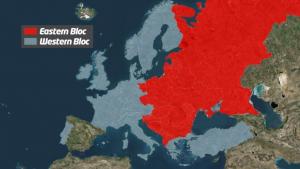
Despite the Catholic Church’s long rejection of materialism, it was a consumer society that brought opposing elements of the Church into a consensus in the “long 1950’s.” James Chappel, in Chapter 5 of Catholic Modern, dates this period from 1949 to 1964.
Chappel’s theme concerns the two different ways Catholics pursued being modern since the 1930’s. In his terminology, “paternal modernists” were the majority, but “fraternal modernists” made up a significant minority. In previous chapters Chappel explores their differences on three intertwining issues – family, the economy, and the state.
The 1950’s, though, were a rare period of Catholic consensus. Memories of the war, with its ideological conflicts, tended to steer former antagonists toward compromise and pragmatic resolution of problems. Stratospheric economic growth during this period made the differences seem irrelevant.
The consumer family
Catholic influencers and political figures played a dominant role in Europe’s becoming a capitalist and consumer society in the 1950’s. That was odd, given the Church’s long-held “suspicion of capitalism and consumerism alike.” Catholics didn’t abandon, but rather reformulated, their social traditions in the process of creating Europe’s most successful political parties. (p. 183)
In the 1950’sCatholics were as opposed to materialism as ever. They rejected a consumerist society built around the desires of the individual. That was hedonism. But material prosperity designed for the needs of the traditional family was well-ordered and moral. (p. 186) Thus there was a good kind of consumer.
From the state Catholics demanded support for traditional family values, including opposition to divorce, abortion, homosexuality, and pornography. They also sought state economic support for families. It was, in this way, a reprise of the paternalist modernity of the 1930’s and 40’s. Paternalists favored large families and wages or welfare to support them.
The fraternalist angle
But the family itself had changed. It was now oriented less toward reproduction and large families and more toward consumption, including housing and labor-saving devices in those homes. Paternalist Catholics had leaned toward the Fascist ideal of families as organs for raising children for the Fatherland. The fraternalist Catholic movement of the 1930’s had resisted the Fascists on this point and seen families more as places of emotional fulfillment. The consumer family was the new social reality on which these two viewpoints could agree. On the one side, state or Church pressure to have children “violated the sanctity of the family unit.” On the other, it was also unnecessary since personal fulfillment includes a natural urge for children. (p. 194)
The ascetic, reproductive family of the 1930’s no longer made sense for an era tired of sacrifice and nationalist ideology. The new family of intimacy, sexuality, and consumption … was more compatible with the spirit of the age. (p. 195)
Even the Church tolerated at least part of this spirit with Pius XII’s acceptance of the rhythm method of birth control. Karol Wojtyla, who would become Pope John Paul II, “praised the sex drive as a necessary and blessed part of our being.” And Pope Paul VI’s encyclical banning artificial means of contraception, nevertheless, was “the most sex-positive encyclical” ever. Marital sex, he said, was “a good and holy thing” even if infertility made reproduction impossible. (p. 199)
Changing ideal of motherhood
More women entered the workforce, but ideal of motherhood still centered around the home. Now, however, a mother would no longer “labor silently beside her husband.” She would “take an active role in social and political life.” (p. 196) Families were shedding their traditional role as producers of goods. The mother’s new job was to be a wise consumer and thus contribute to the healthy development of the economy. (p. 198-99) Economy rather than fatherland was the new focus of state support for families.
The Christian Democratic movement in Europe succeeded, at least partially, in aiding families, which were, indeed, in serious trouble after the war. Their one-sided focus on the family, however, left them unwilling to tackle other social ills, such as inequality between social classes. They tended to ignore the demands of feminists, gays, and, most importantly, the working class.
The working class in the social market economy
Neither Catholic institutions nor the official Church complained about the soaring economy of the 1950’s. That doesn’t mean they had become pure capitalists. Rather, they looked for what the economy could do for the family. Above all, the family needed working fathers who could earn enough so that mothers would not need to work. Christian Democrats knew that a free labor market could not provide the “family wage.” They pursued a “reformed sort of capitalism that provided a significant safety net and balanced the rights to private property with the dignity of the worker.” (p. 201)
A significant part of making this version of capitalism work was codetermination, that is:
The idea that the worker, organized into free and independent trade unions, had the right to a share in either the management or the profits of his firm. (p. 201)
The mid-1940’s saw a push toward nationalizing industries and banking. In the 50’s Christian Democrats revived anti-Communism and the old Catholic suspicion of state control. Worker participation seemed an alternative to big government, and Catholics and socialists were able to find common ground. (p. 207)
Compromise
Enthusiasm for codetermination ebbed eventually. German Catholics had declared specific forms of codetermination a demand of natural law. German socialists read from papal social teachings. (p. 208) Protestants and Pope Pius XII, however, pushed in the opposite direction, both of them favoring the principle of private property. Pius declared that natural law supported private property, but not worker-management codetermination.
Out of this impasse, widely supported compromise solutions developed. In Germany, for example, codetermination was the rule in coal, iron, and steel. Large companies saw one-third representation of workers on supervisory boards. (p. 210)
There was no great reorganization of the capitalist economy, but support for workers was genuine, especially on two important issues—retirement and pensions. Here another compromise developed between voluntary saving for one’s own retirement and state-mandated savings. In the new system,
The current generation of workers would fund the new generation of retirees directly, in a ‘contract of solidarity’ between generations. (p. 212)
The system did not address poverty since pension amounts depended on one’s own previous earnings. Women were at a disadvantage, especially, since men generally worked longer and at higher wages.
Changing dogmas
In 1961 Pope John XXIII went along with the consensus. His encyclical Mater et Magistra had no criticism for capitalism. Properly regulated social progress “would heal inequalities and raise the standard of living for all.” (p. 212-13) On the matter of codetermination the encyclical was equally supportive of the rights of employers to dispose of their property and the rights of workers for some say in management.
That moderate position was to change within a few years. The Second Vatican Council’s Gaudium et Spes said little about employers’ rights but promoted worker involvement at high levels of administration and worker sharing of profits.
The one dogma that remained the same however was the belief that time alone would solve the problems of poverty and inequality—time for the economy to grow.
Economic development, the main task of the state
The Church was enjoying a new love affair with growth, but for the state growth was the key to its very legitimacy. Abandoned were the old justifications of religious traditions or the ideology of the West. Anti-Semitism also went into hiding, more or less, among Christian Democrats if not for the more right wing parties. (p. 214-15) Party leadership had transitioned from populists with “mythological vision” to “efficient and somewhat colorless technocrats.” (p. 216)
In fact, though, growth was the new mythology. It supplanted not only nationalistic and religious divisiveness but also discussions of how to achieve justice. The consumer society assumed that economic growth would make life better for all without the painful question of distribution. All we needed was time before even “third-world” countries would experience the benefits of “development.” (p. 217)
It was a change in the Church’s attitude toward Capitalism, but not one that abandoned basic Catholic principles. The Church still condemned both individualism and collectivism while supporting the family as the basic social unit. Wages and prices were still both moral and political issues as was state support for families in need. (p. 219)
“Good” Capitalism
Development was the main moral requirement, and as long as economies were growing, Capitalism was good. A new “scientific” point of view meant “rationalization” of production and markets through competition. An Austrian Catholic economist declared,
Anyone who expects [economists to be uttering] radical or stirring slogans from Catholic social teaching is bound to be disappointed. (p. 222)
It was a time for “Christian realism.” At that time Church leaders too were calling economic development, properly managed, the path to justice. Pope John’s Mater et Magistra said development was “the new name for peace.” (p. 224)
Stability, compromise, and the family were keys to the consensus of the “long 1950’s.” An incisive critique of consumerism, concern for the environment, and the rights of women and minorities were present but on the margins. These issues and the project of facing the “kinds of suffering or social dislocation that could not be coded as familial” waited for the later 1960’s.
Image credit: Social.Rollins.edu via Google Images












